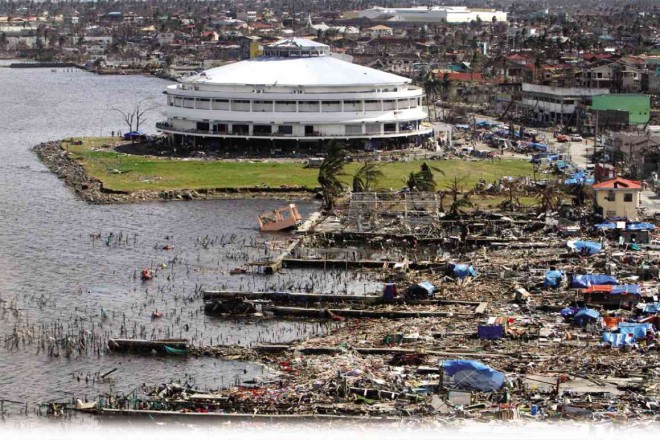Tacloban cleanup yields human bones

AN AERIAL view of part of Tacloban City, taken three days after Supertyphoon “Yolanda” (international name: Haiyan) struck and showing a scale of devastation comparable with that caused by the explosion of the world’s first atomic bomb in Hiroshima, shows entire communities flattened and an astrodome next to the Cancabato Bay barely standing. INQUIRER PHOTO
TACLOBAN CITY—In the past two years, the biggest bay in the city has kept the horrific scenes brought by the strongest typhoon to hit land.
These scenes may just be unraveled as the Public Attorney’s Office (PAO) has launched a cleanup of Cancabato Bay where it is believed that the remains of up to 1,600 people, who died at the height of Supertyphoon “Yolanda” (international name: Haiyan) and are still unlisted, are buried along with vehicles and appliances.
So far, divers commissioned by the PAO recovered on Wednesday two full sets of skeletal remains of adult persons, skeletons of half a body and two skulls.
The team also retrieved a hood of a car and a basketball jersey.
PAO chief Persida Rueda Acosta, who led the retrieval operations with a forensic team headed by Dr. Erwin Erfe, said the operation stemmed from the letter-request sent by Losanto P. Castillo Jr., chair of Tacloban Fisherfolk Urban Association (TFUA) of Barangay 88, also known as Fisherman’s Village.
Article continues after this advertisementThe letter was hand-carried by running priest Fr. Robert Reyes, who was in Tacloban during the second year commemoration of Yolanda on Nov. 8.
Article continues after this advertisementIn his letter to Acosta, Castillo said he and his group believe that the remains of at least 1,600 people who died during Yolanda are still in the bay.
He added that vehicles, house appliances and other personal possessions that were washed out during the storm surge also sank in the bay.
Castillo asked that the bay be cleaned and offered his group’s help. He said he and his group were willing to work with the local government unit, nongovernment organizations and other organizations for the cleanup.
Emilio Dador, 65, the vice president of TFUA, explained that the bay has become so polluted after Yolanda that fishermen’s catch had dropped by 60 percent.
Dador said his group asked the Tacloban City government, the committee on fisheries in the city council and some organizations to conduct a cleanup operation on the bay.
But he added that the plea was not heeded.
Cancabato Bay spans 14 villages in San Jose District, Tacloban City. When it hit land on Nov. 8, the supertyphoon generated a storm surge from the bay that wiped out every structure that stood its way.
San Jose District, the biggest coastal district in Tacloban, suffered the brunt of Yolanda.
The death toll in San Jose District is said to be the highest and those missing might have been washed into the bay.
Although there was no official death toll in the district alone, city officials expressed belief that 2,000 of the 2,300 reported deaths in Tacloban came from San Jose District.
Father Reyes, who was with Acosta and her group on Wednesday, said it is time to clean up the bay but the government should also provide an alternative source of livelihood to the affected fishermen.
“We hope people will come up with their stories to match the identity of the skeletons,” said Acosta.
“We should return these skeletal remains to their loved ones, so they will have closure,” she said.
She added that if no one would claim the remains, they should be preserved as archeological finds.
On Nov. 7, a pedicab driver stumbled on a skull while scavenging for firewood and electrical wires at the back of a public high school in Barangay 87 in San Jose District.
He reported the find to barangay officials who sent in watchmen to dig deeper at the site where the skull was found.
After an hour, six skeletal remains—four adults and two children—were found by the team. These were later turned over to the National Bureau of Investigation for forensic examination.